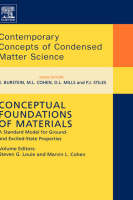
Conceptual Foundations of Materials
Elsevier Science Ltd (Verlag)
978-0-444-50976-5 (ISBN)
- Titel ist leider vergriffen;
keine Neuauflage - Artikel merken
The goal of this Volume "Conceptual Foundations of Materials: A standard model for ground- and excited-state properties" is to present the fundamentals of electronic structure theory that are central to the understanding and prediction of materials phenomena and properties. The emphasis is on foundations and concepts. The Sections are designed to offer a broad and comprehensive perspective of the field. They cover the basic aspects of modern electronic structure approaches and highlight their applications to the structural (ground state, vibrational, dynamic and thermodynamic, etc.) and electronic (spectroscopic, dielectric, magnetic, transport, etc.) properties of real materials including solids, clusters, liquids, and nanostructure materials. This framework also forms a basis for studies of emergent properties arising from low-energy electron correlations and interactions such as the quantum Hall effects, superconductivity, and other cooperative phenomena.
Although some of the basics and models for solids were developed in the early part of the last century by figures such as Bloch, Pauli, Fermi, and Slater, the field of electronic structure theory went through a phenomenal growth during the past two decades, leading to new concepts, understandings, and predictive capabilities for determining the ground- and excited-state properties of real, complex materials from first principles. For example, theory can now be used to predict the existence and properties of materials not previously realized in nature or in the laboratory. Computer experiments can be performed to examine the behavior of individual atoms in a particular process, to analyze the importance of different mechanisms, or just to see what happen if one varies the interactions and parameters in the simulation. Also, with ab initio calculations, one can determine from first principles important interaction parameters which are needed in model studies of complex processes or highly correlated systems. Each time a new material or a novel form of a material is discovered, electronic structure theory inevitably plays a fundamental role in unraveling its properties.
Steven Louie is Professor of Physics at UC Berkeley. His research spans a broad range of topics in condensed matter theory and nanoscience. He is a member of the National Academy of Sciences and recipient of the APS Aneesur Rahman Prize for Computational Physics, the APS Davisson-Germer Prize in Surface Physics, and the Foresight Institute Richard P. Feynman Prize in Nanotechnology. Marvin Cohen is University Professor at UC Berkeley. His research covers a broad spectrum of subjects in theoretical condensed matter physics. He is a member of the National Academy of Sciences and recipient of the National Medal of Science, the APS Oliver E. Buckley Prize for Solid State Physics, the APS Julius Edgar Lilienfeld Prize, and the Foresight Institute Richard P. Feynman Prize in Nanotechnology. He was 2005 President of the American Physical Society.
1. Overview - A Standard Model of Solids
1.1 Background
1.2 The Hamiltonian
1.3 Emperical models
1.4 Ab initio calculations
1.5 Other sections
2. Predicting Materials and Properties - Theory of the Ground and Excited States
2.1 Introduction
2.2 The ground state and density functional formulism
2.3 Ab initio pseudopotentials
2.4 Electronic, structural, vibrational and other ground-state properties
2.5 Electron-phonon interaction and superconductivity
2.6 Excited states, spectroscopic properties, and Green's functions
2.7 Single-particle Green's function and electron self energy
2.8 The GW approximation
2.9 Quasiparticle excitations in materials
2.10 Electron-hole excitations and the Bethe-Salpeter equation
2.11 Optical properties of solids, surfaces, and nanostructures
2.12 Spectroscopic properties of nanotubes - a novel 1D system
2.13 Summary and perspectives
3. Ab Initio Molecular Dynamics - Dynamics and Thermodynamic Properties
3.1 Molecular Dynamics
3.2 Potential energy surface and electronic structure
3.3 Ab-initio Molecular Dynamics: the Car-Parrinello approach
3.4 Numerical implementation
3.5 An illustrative application: liquid water
3.6 Phase diagrams from first-principles
3.7 Rare events
3.8 Omissions, perspectives and open issues
4. Structure and Electronic Properties of Complex Materials: Clusters, Liquids and Nanocrystals
4.1 Introduction
4.2 The electronic structure problem
4.3 Solving the Kohn-Sham problem
4.4 Simulating liquid silicon
4.5 Properties of confined systems: clusters
4.6 Quantum confinement in nanocrystals and dots
5. Quantum Electrostatics of Insulators - Polarization, Wannier Functions, and Electric Fields
5.1 Introduction
5.2 The polarization
5.3 Outline of density-functional perturbation theory
5.4 The Berry-phase theory of polarization
5.5 Reformulation in terms of Wannier functions
5.6 The quantum of polarization and the surface charge theorem
5.7 Treatment of finite electric fields
5.8 Conclusions
6. Electron Transport
6.1 Introduction
6.2 Conductivity
6.3 Conductance versus conductivity ; the point contact
6.4 Kubo and other formulas
6.5 Supercurrent and Andreev reflection
6.6 Bloch-Boltzmann theory
6.7 Kondo effect and resistivity minimum in metals
6.8 Dirty Fermi liquids and intrinsically diffusive states
6.9 Weak localization and quantum corrections
6.10 Neutron, photoemission, and infrared spectroscopies
6.11 Semiconductors and the metal/insulator transition
6.12 Coulomb blockade
6.13 Coulomb gap
| Erscheint lt. Verlag | 20.9.2006 |
|---|---|
| Reihe/Serie | Contemporary Concepts of Condensed Matter Science |
| Verlagsort | Oxford |
| Sprache | englisch |
| Maße | 165 x 240 mm |
| Gewicht | 530 g |
| Themenwelt | Schulbuch / Wörterbuch |
| ISBN-10 | 0-444-50976-3 / 0444509763 |
| ISBN-13 | 978-0-444-50976-5 / 9780444509765 |
| Zustand | Neuware |
| Haben Sie eine Frage zum Produkt? |
aus dem Bereich


